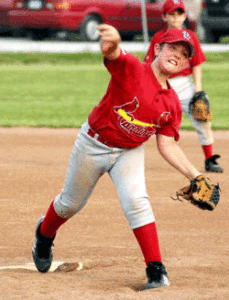When Should Kids Learn Curveballs?
Today, we’ve got the first in a series of Q&A contributions from Matt Blake.
Q: What do you think of Ron Johnson’s presentation at the ABCA convention where he stated that curveballs are okay for youths to throw and that they do not cause any structural damage beyond what a fastball does? Rather, it was the frequency the curveball was thrown that was the indicator.
A: I was at Ron Johnson’s presentation and have had the chance to read much of the research that has been presented on this topic. I do generally agree that curveballs are not inherently more dangerous than fastballs, but I think the idea of curveballs sends a conflicting message at the youth levels.
Fundamentally, I’d like to believe that this game is centered around the pitcher being able to locate a fastball to the center of the plate 100 out of 100 times. Obviously, this is an idealistic perspective, but above average fastball command should be the trademark of an advanced youth player, not the fact that he can spin a baseball with his hand in a supinated position so that he can fool unsuspecting 11 year olds. We don’t teach hitters to focus on curveballs at this age, so why should we teach pitchers to throw them?
Squaring up the fastball over the middle of the plate is step one for both hitters and pitchers. In order to put a player in the best chance to succeed down the road, I think a pitcher should be able to repeat his fastball mechanics and create a certain amount of hand-speed, before he is taught to craft his pitching skills. This is generally considered to be a throwing mechanics versus pitching skills debate and would prioritize mechanical knowledge and the sequencing of the body’s rotations.

If a player has demonstrated above average command of his fastball to the center of the plate, then obviously, the next progression would begin to zone the plate off for him. Once he can dissect the lanes of the plate with a straight fastball, then maybe teach him a different grip on the fastball or even a changeup. Start by working the changeup down the middle, etc….This game is built on efficient pitching, so to skip steps at these early developmental levels or to place too great an emphasis on winning at this age would compromise the player’s development. Obviously, all of this is just simply my opinion.
When would I teach a breaking ball? I guess it would be when a player looks skeletally mature to repeat his delivery and can demonstrate effective use of his fastball/changeup combination. If these pieces are set as the foundation, introducing spin tilt and depth might follow. If a player at the age of 11 or 12 is capable of doing this because he has put the necessary repetition in, then I suppose you can’t hold him back, but for some reason, I think people might be skipping steps 2 and 3 to get to 4, because 4 gets outs easier at age 12.
Have a question for Matt? Drop him an email at mablak07@gmail.com.
Sign-up Today for our FREE Baseball Newsletter and Receive a Copy of the Exact Stretches
used by Cressey Performance Pitchers after they Throw!



